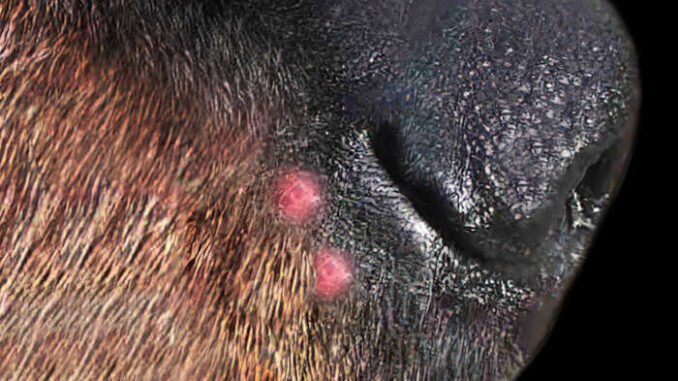
This article was updated on January 9th, 2024
Your dog’s nose is incredibly important to them, since they rely on their sense of smell to understand their environment. Seeing a red spot or pimple on your dog’s nose can be concerning—but should you be worried? At my clinic, I see red spots and pimples on dog’s noses all the time. In this article, I will discuss things you should know and when to take your dog to see a vet.
5 Things to Know About Pimples on Your Dog’s Nose:
1. Nose pimples or red bumps could be caused by an injury, allergy, infection, or acne.
“Most of the time, red bumps or nose pimples are not a major concern. Depending on the cause, these bumps will sometimes clear up on their own; other times, they may require topical or oral medications.”
Here a few common reasons why you may see a red bump on your dog’s nose:
Trauma (injury)
Dogs explore the world with their noses and this often leads to them poking them in things they shouldn’t. If your dog has got on the wrong side of a thorny bush, a cat, or even the corner of a table, you may see the evidence on their nose. If it’s sore and bothering them, it’s best to get it seen by your vet. However, if it’s only a small red spot or graze, it’s likely to heal by itself. Look out for any signs of infection such as:
- swelling,
- increased pain, or
- discharge
Allergies, bites, and stings
Dogs’ inclination to explore the world with their nose can also lead to ‘contact allergies’ (for example, an allergy to a specific plant), insect bites, and stings—especially in the summer months. These can cause a reddened area or spot to appear as well as itching and swelling. Pictured below is a small red bump due to an insect bite:
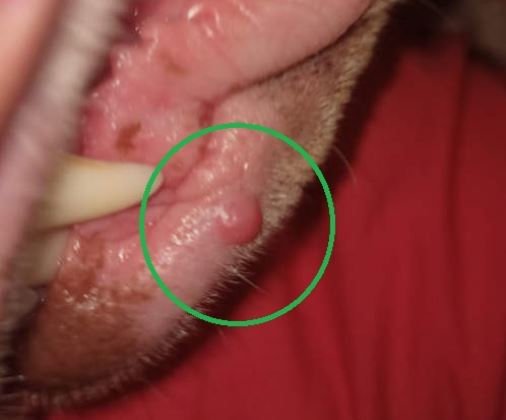
If your dog is distressed or the swelling and inflammation are severe, it’s worth seeing a vet as they may need medication. Luckily, many insect bites, stings, and allergic reactions will settle over a couple of days on their own. If you suspect your dog has been in contact with a toxic substance, you should always contact your vet for advice.
Infections
Infections can develop anywhere on your dog’s skin, including over the muzzle and around the nose. Bacterial infections typically cause redness, little bumps (papules), and pimples, also known as pustules. Ringworm, a fungal infection, is more likely to affect a focal circular area and cause white crusting. Infections can also cause itchiness and discomfort.
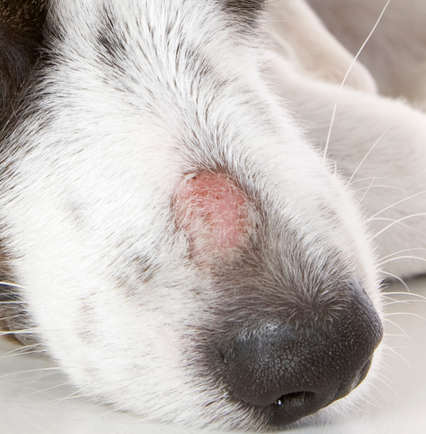
Mild infections—for example, a few pimples developing after a dog has grazed its nose—may resolve with time. See a vet if they:
- last more than a few weeks,
- are spreading,
- cause distress, or
- are very inflamed.
Acne
“Mainly seen in young, short-coated breeds, canine acne can cause red bumps and pimples to develop across your dog’s muzzle, lips or chin. The cause isn’t fully understood. Potential causes include genetics, trauma and allergies. It’s thought that rubbing or scratching the skin breaks the hairs and pushes them deeper into the skin, resulting in inflammation and secondary infection.”
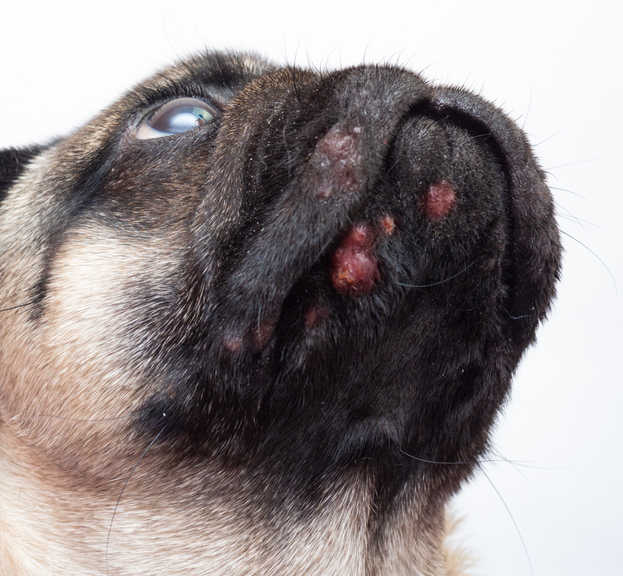
Treatment may include topical or oral medication as well as addressing any underlying causes. Learn more about dog acne & pimples with more pictures & treatment information.
2. Benign or malignant tumors can also appear as a bump on a dog’s nose.
Tumors on the nose are relatively uncommon, but we can still see a range of different growths affecting the muzzle, nose, and lips. These include mast cell tumors, soft tissue sarcomas, squamous cell carcinoma and benign growths.
“Benign growths, like histiocytomas and warts, are much more common in young dogs. Older dogs, on the other hand, are at greater risk of developing malignant tumors.”
Tumors on the nasal planum itself (the hairless part of the nose) are less common. The main tumor seen here is squamous cell carcinoma, which can be very aggressive. Early diagnosis is essential for treatment.
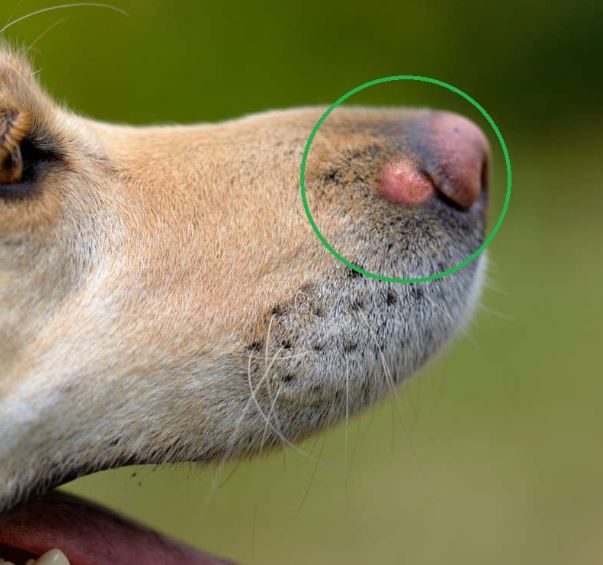
In addition to the appearance of a growth on your dog’s nose, other symptoms to look out for include:
- Nasal discharge
- Nose bleeding
- Asymmetry of the face or deformity
- Twitching of facial muscles/neurological symptoms
- Sneezing
Any new, persistent lump in this area should be assessed by a vet. Not all tumors are necessarily malignant. A diagnostic test in your veterinarian’s office is often required to confirm an exact and accurate diagnosis. Early diagnosis is critical for treatment.
If a new nose bump is indeed a skin tag, wart, or cyst, a veterinarian will usually just leave it alone. They may monitor it to ensure it is not bothering your dog or becoming infected. On the other hand, if the diagnostic test indicates this is a tumor, surgery might be recommended.
3. When red spots or lumps don’t clear up for several weeks, see a vet.
“Most pimples and red spots clear up on their own within a few weeks. Any red spot, pimple or lump that persists for several weeks should be checked by a vet.”
There are also some indications that your dog may need to visit a vet more urgently. These include:
- Progression: The affected area spreading out or becoming more inflamed. If a lump grows rapidly, a vet should assess it sooner rather than later.
- Severe inflammation: This can cause soreness or itching. Have your dog see the vet if they are clearly in distress.
- Bleeding: Continuous bleeding or oozing is never a good sign. Take your dog to the vet if you keep seeing blood.
- Systemic symptoms: If your dog is lethargic, reluctant to eat, or showing other symptoms like sneezing and nasal discharge, they need to be seen more urgently.
4. Your vet may run tests, including a biopsy or skin scrape.
It is usually not possible to diagnose a new bump or spot just by looking at it. For example, the red spot in the picture below could be a benign wart or cyst that could be left alone. It could also be a cancerous growth that requires treatment as soon as possible:
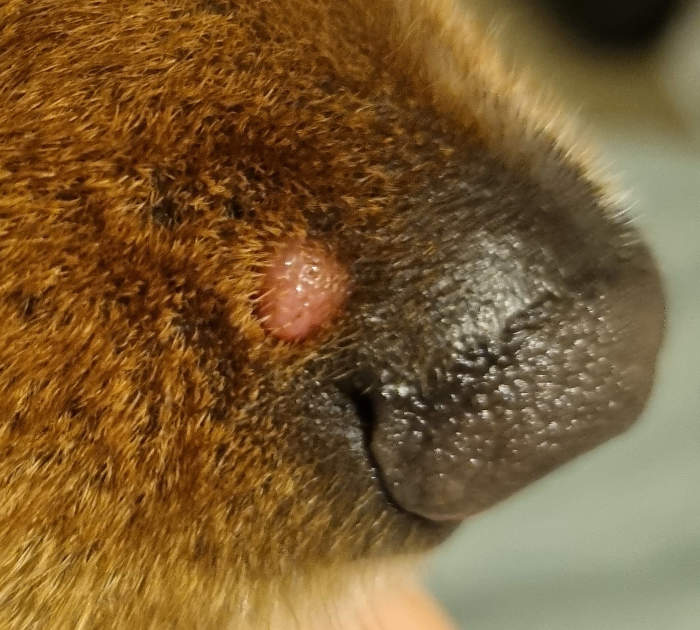
Your vet will likely run tests to get to the root of the problem and make sure your dog is healthy.
Their recommendations will depend on the suspected cause and could include topical or oral medications, surgery, or other treatments.
Further tests may include:
- Fine needle aspirate (FNA): If your vet suspects a tumor and it’s large enough, they may take a small needle sample to assess under a microscope. This usually costs $150-200.
- Biopsy: If they can’t take an FNA or there are more diffuse changes affecting your dog’s nose or muzzle, your vet may recommend a punch biopsy under sedation or anesthetic. Costs depend on the exact procedure but typically range from $400-800.
- Skin scrape: If your vet suspects an infection, they may recommend a skin scrape to identify bacteria or fungal elements.
Learn more about FNAs and Biopsies to diagnose skin issues in dogs.
5. Rarely, an autoimmune condition could be to blame.
Autoimmune disease in dogs is uncommon but can affect the nose. Cutaneous lupus and pemphigus, for example, can cause redness, ulceration and swelling on and around the nose.
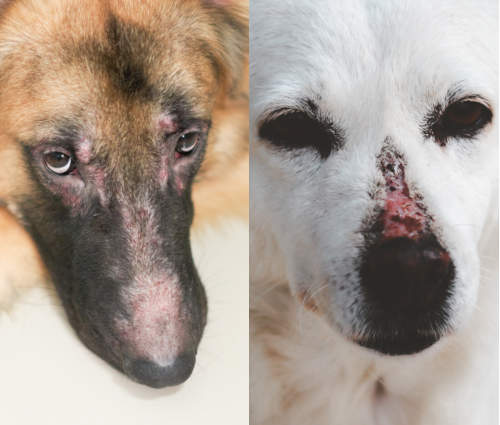
In their early stages, you may only notice a small red spot. These are progressive if left untreated but the prognosis is usually good with treatment. With most autoimmune conditions, treatment will involve long, tapering courses of medication. Learn more about autoimmune conditions.
Related posts:
Scabs and Lumps on Your Dog’s Nose: Top Causes
Disclaimer: This website's content is not a substitute for veterinary care. Always consult with your veterinarian for healthcare decisions. Read More.


Be the first to comment